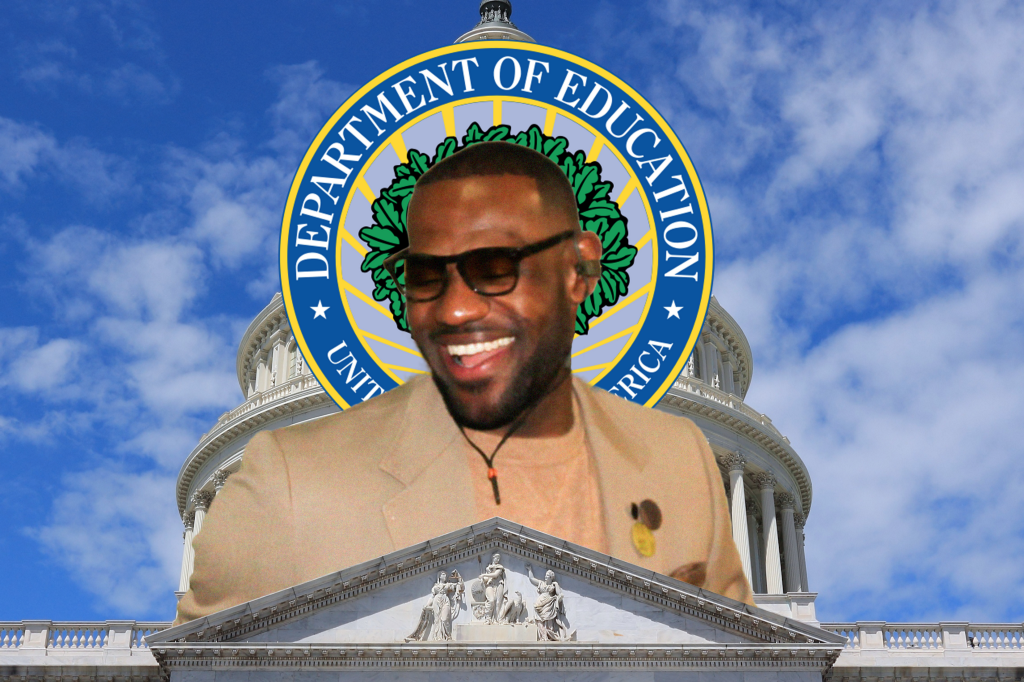LeBron James is entering the twilight of his career with an eye on his legacy — not just as a hyper-efficient deep-three shooter, a mentor to his young new Lakers teammates or even the increasingly likely Greatest of All Time, but as an educator to underprivileged and at-risk children in his Ohio hometown.
James’ I Promise School, which opened Monday in Akron, marks a commitment to its community that is as awe-inspiring as James’ athleticism. It may actually be his greatest achievement. And it reveals a radical vision for social progress that could carry LeBron into a post-NBA political career, should he choose it.
What’s exceptional about I Promise is a combination of resources, preparation, innovation and ambition, education experts tell me. The school’s goal is explicit: to give each kid the best possible shot at success, knocking down every possible challenge in their way and alleviating the burdens of low-income families. The key “promise,” repeated by the kids in a lively morning call-and-response, is to “FINISH SCHOOL.”
@KingJames 3rd graders are reciting the #IPROMISE for the first time in their new home with Principal Davis! ❤️? #WeAreFamily pic.twitter.com/Gitytnq31t
— I PROMISE School (@IPROMISESchool) July 30, 2018
Ohio Is Failing Its Most Vulnerable Students
No wonder I Promise is such a beacon of hope: The community sorely needs a boost.
Akron has a 40.2 percent child poverty rate, according to 2016 U.S. Census Bureau statistics. Statewide, the child poverty rate is about one in four. Ohio schools are suffering, and Republican Gov. John Kasich refuses to confront the consequences of his unpopular education cuts. U.S. News & World Report ranks Ohio 41st in the country in education. In 2010, Ohio ranked sixth in the nation in Education Week’s annual Quality Counts report. In 2016, it slid to 23rd, likely due to weak student achievement, reports the Columbus Dispatch. One critical takeaway: “Ohio had among the largest gaps on national test scores between students living in poverty and their higher-income classmates, ranking 43rd in the nation.”
To that end, the I Promise school provides free meals and snacks, free uniforms, free bicycles and helmets, free transportation (within two miles), a food pantry, job-placement services and GED programs for families. When the students graduate, I Promise offers guaranteed tuition to the University of Akron, beginning in 2021. The school day is longer; the school year is too. (Right now, the curriculum is third and fourth grade only, but it plans to expand to first through eighth grade by 2022.)
It also looks like like no public elementary school you’ve ever seen. No wonder the kids are literally wide-eyed with wonder—
Congrats to my Brother @KingJames on the opening of his #IPromise School in his hometown of Akron. The look on this boys face as he enters the school says it all. Love. pic.twitter.com/XhtK7P4upc
— COMMON (@common) July 30, 2018
—this is the look of an institution that’s investing in them.
The @LJFamFoundation's I Promise School opens in Akron Monday. It will be the new Akron Public Schools' home to 240 at-risk 3rd & 4th graders. Take a sneak peak inside!
Read more: https://t.co/JIUWLWO1jF
?s: Jennifer Conn, https://t.co/a4YA4W2Cro pic.twitter.com/Fx989ZXeAE— clevelanddotcom (@clevelanddotcom) July 30, 2018
They Won’t Go to School Hungry
It’s obvious LeBron’s done his research, says Howard Fleeter, a consultant with the Ohio Education Policy Institute: “When I see the job this school is doing, it’s consistent with what we know about the types of interventions you need to make with economically disadvantaged kids.”
These services “can and do help the majority of students who need them,” says Margaret (Macke) Raymond, director of CREDO, a nonpartisan research group at Stanford University studying education policy. She praised I Promise for selecting students “that many other schools would prefer to ignore or send elsewhere.”
Fleeter lauded I Promise’s extended school year and daily hours, which let working parents work and cut down “summer learning loss,” a major factor in the achievement gap between low- and high-income students. “When you test high-income kids in May, at the end of the year, and in August, at the beginning of the next, higher-income kids come back at the same place they left or sometimes even ahead,” he says. “Low-income kids come back after vacation and tend to be one to two months behind where they were.”
That’s why the summer program is “huge,” he says. “School is usually six hours a day, 180 days a year—about 25 percent of the time these kids are awake. There are issues at home they have to overcome. But they’re only in the place they have to overcome them 25 to 35 percent of the time.”
The food services are critical, too. “Higher-income kids don’t have to worry when their next meal is going to be,” Fleeter says. “They’re not going to school hungry.”
The Charter School Problem
Notably, I Promise is a public school, unlike the charter schools opened by former NBA stars David Robinson and Jalen Rose. That’s one reason its innovations feel so daring: Ohio, like many other states, has experimented heavily with charter schools, a disruptive challenge to the public-school system that aims to combat statewide low test scores with additional education options for families. These schools are privately run but funded by state taxes, forcing public schools to compete over limited funds in what amounts to a zero-sum game.
But the essential argument for charter schools is a free-market fantasy—that less money will actually inspire better performance and improve our country’s sordid state of public education through competition. Betsy DeVos, the secretary of education under President Trump, built her career championing charter schools in Michigan through her philanthropic work. It should be easy for her to point to areas where her schools have been successful. She can’t, because they haven’t.
In Ohio, some charter schools have seen slightly higher test scores but lower student progress. They also suffer from wild misallocations of public funding. The system is so negligent it’s literally a joke; it was openly mocked and scorned at a 2015 education conference.
Make no mistake, charter schools can work, and there are many good charter schools in Ohio, Fleeter says. The problem? No oversight. “Shady proprietors don’t have kids’ interests at heart,” Fleeter says. The I Promise School, however, “is exactly what charter schools were supposed to do—find ways to innovate and do things differently.” Rather than pitting James’ school against the school district, it’s a cooperative effort. Results might not be immediate, he cautions, but “Akron City Schools has everything to gain. Everything I see about this I find really encouraging. … If this thing works, it could really benefit the charter school industry in Ohio too. These schools really can work if they’re properly managed.”
Raymond, the director of CREDO, says it’s too early to make a judgment about Ohio charter schools; her organization is still researching their progress. But: “If a charter cannot fulfill its mission, I think active intervention is needed,” she says. “It’s required if students aren’t getting the real chances they deserve.” A successful school, she says, “ensures great teachers have the skills and resources needed to meet every student where they are and help them advance.”
Where DeVos Falls Short, James Has Solutions and Experience
I Promise School principal Brandi Davis says “family wraparound support” is the “missing link in public education.” She tells the L.A. Times, “Our students come to school, and they’re worried about things at home. … We want to create that safe, that secure and that caring and loving environment for our families and our students so that our kids can focus on education.”
Aaron Pallas, Arthur I. Gates Professor of Sociology and Education at Teachers College, Columbia University, tells me these services are crucial. “If children don’t come to school ready to learn, they will not learn very much. For the school, that means that children don’t come to school hungry, have access to nutritious foods, have been screened for vision, hearing, asthma and other ailments, and have access to social and psychological counseling services that may be necessary to address exposure to potentially traumatic events in their families and neighborhoods.” He calls himself “cautiously optimistic” about James’ plan.
Other experts were more effusive, particularly toward LeBron. “Mr. James deserves credit and gratitude that he decided to focus on public education for this initiative,” Raymond says. “Efforts like Mr. James’ are critical to show communities what true school success looks like for their communities’ students.” It matters, too, that he’s a powerful public figure: “Mr. James can have a great deal of influence in the public debate,” she adds.
What’s equally important, Fleeter says, is that James is a product of the same system he’s looking to help. “He’s been that kid. [He knows] what kinds of things he was missing, what would have been helpful to him. That’s the kind of person you want setting up a school to help those kids.”
Fleeter says James seems thoughtful and intelligent in his approach, unlike DeVos, who has spent her time as secretary of education working to reduce regulations that protect students. “If your job really is to oversee those schools and see what the federal government can do to help them do their jobs, [DeVos’] background makes her an unlikely person for that position,” Fleeter says. “She doesn’t understand some very basic things about how public schools work.”
What about James? “LeBron, from his own personal experience, seems to have better ideas about the things public schools need than the person in that job right now. I’ll leave it at that.”
LeBron for GOAT. LeBron for secretary of education. LeBron for president.

